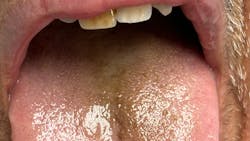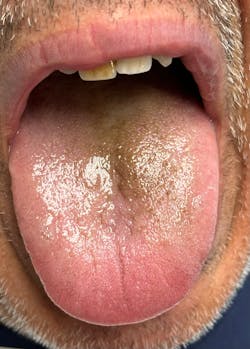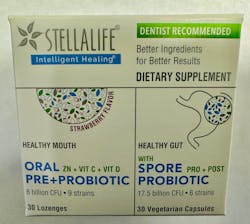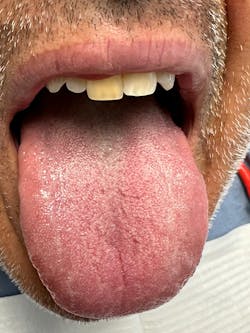Black hairy tongue (appearance of a black tongue)—also known as lingua villosa nigra—is a black appearance on the top (dorsal surface) of the tongue and growth of the papillae on the tongue that make it appear as if hair is growing there.1 While it is named black hairy tongue, the tongue can also appear brown, yellow, green, or bluish (figure 1).2 Black hairy tongue typically does not hurt, but bad breath (halitosis), altered taste (dysgeusia), dry mouth (xerostomia), and/or burning of the tongue can occur.3
Causes of black hairy tongue
The exact cause of black hairy tongue is thought to be a growth of cells on the tongue that increase the size of tongue papillae, which then trap bacteria or yeast that produce chromatin and turn the tongue black.4 These extra cells can also accumulate bacteria from food, coffee, tea, and tobacco that can stain them and turn the tongue a darker color.
You may also be interested in …
Diseases most likely to affect the tongue and the importance of proper examination and diagnosis
Studies have shown that black hairy tongue can occur in 1%–11% of the population. It occurs in males at three times the rate of females due to higher smoking rates and poor oral hygiene in males. The rate of this condition also increases in those older than 60.5
Factors that increase the risk of developing black hairy tongue
- Poor oral hygiene
- Smoking or chewing tobacco, alcohol, illicit drugs
- Certain medications6: antibiotics (like tetracycline), psychiatric medications (especially ones that cause xerostomia), and chemotherapeutic agents
- Mouthrinses7: chlorhexidine gluconate and other oxidizing mouthrinses
- Systemic illness8: immunocompromised patients such as those with AIDS, advanced cancer, graft-versus-host disease, amyotrophic lateral sclerosis, chronic xerostomia, or who have received recent radiation therapy to the head or neck
- COVID-19
Black hairy tongue should be differentiated from fake black tongue (pseudo–black hairy tongue), which can occur when the tongue becomes stained from coffee/tea, food coloring, or medications that contain bismuth subsalicylate (Pepto-Bismol)
Treatment for black hairy tongue
Aside from looking scary, black hairy tongue is benign. Treatment consists of mechanical debridement with a tongue scraper and a toothbrush, as well as removing the causative factors if possible.
As an adjunct to conventional debridement and to facilitate removal of the black color from the tongue, this author advocates the application of StellaLife Vega Oral Care Gel to the tongue prior to tongue scraping (three times a day) and StellaLife Vega Oral Rinse (three times a day). In addition, taking StellaLife Probiotic Oral Lozenge (figure 2) twice a day for 10 days will foster an environment of good bacteria in the mouth to improve both the health and color of the tongue.
Black hairy tongue generally resolves within days to weeks after implementation of oral care and removal of the etiologic factors (figure 3). Patients who do not respond to this treatment after a few weeks may need to undergo further treatment, such as laser application to the tongue surface.9
Editor’s note: This article originally appeared in Perio-Implant Advisory, a chairside resource for dentists and hygienists that focuses on periodontal- and implant-related issues. Read more articles and subscribe to the newsletter.
References
- Schlager E, St Claire C, Ashack K, Khachemoune A. Black hairy tongue: predisposing factors, diagnosis, and treatment. Am J Clin Dermatol. 2017;18(4):563-569. doi:10.1007/s40257-017-0268-y
- Ren J, Zheng Y, Du H, et al. Antibiotic-induced black hairy tongue: two case reports and a review of the literature. J Int Med Res. 2020;48(10):300060520961279. doi:10.1177/0300060520961279
- Thompson DF, Kessler TL. Drug-induced black hairy tongue. Pharmacotherapy. 2010;30(6):585-593. doi:10.1592/phco.30.6.585
- Braggio C, Bocchialini G, Ventura L, Carbognani P, Rusca M, Ampollini L. Linezolid-induced black hairy tongue. Acta Biomed. 2018;89(3):408-410. doi:10.23750/abm.v89i3.7060
- Avcu N, Kanli A. The prevalence of tongue lesions in 5150 Turkish dental outpatients. Oral Dis. 2003;9(4):188-195. doi:10.1034/j.1601-0825.2003.02933.x
- Ren J, Zheng Y, Du H, et al. Antibiotic-induced black hairy tongue: two case reports and a review of the literature. J Int Med Res. 2020;48(10):300060520961279. doi:10.1177/0300060520961279
- James P, Worthington HV, Parnell C, et al. Chlorhexidine mouthrinse as an adjunctive treatment for gingival health. Cochrane Database Syst Rev. 2017;3(3):CD008676. doi:10.1002/14651858.CD008676.pub2
- Jayasree P, Kaliyadan F, Ashique KT. Black hairy tongue. JAMA Dermatol.2022;158(5):573. doi:10.1001/jamadermatol.2021.5314
- Schuster GM, Roberts EP, Tarpey HE. A novel approach to treating hairy tongue. Dimens Dent Hyg. 2023;21(1):42-45.
About the Author

Scott Froum, DDS
Editorial Director
Scott Froum, DDS, a graduate of the State University of New York, Stony Brook School of Dental Medicine, is a periodontist in private practice at 1110 2nd Avenue, Suite 305, New York City, New York. He is the editorial director of Perio-Implant Advisory and serves on the editorial advisory board of Dental Economics. Dr. Froum, a diplomate of both the American Academy of Periodontology and the American Academy of Osseointegration, is a volunteer professor in the postgraduate periodontal program at SUNY Stony Brook School of Dental Medicine. He is a PhD candidate in the field of functional and integrative nutrition. Contact him through his website at drscottfroum.com or (212) 751-8530.




